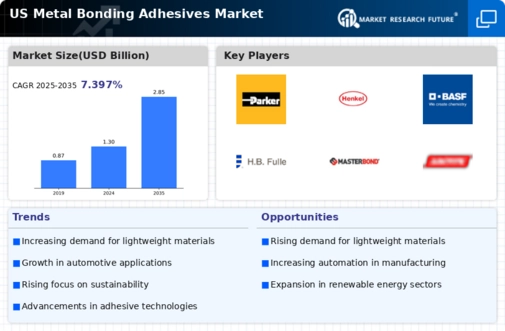The competitive landscape of the US Metal Bonding Adhesives Market is characterized by a diverse array of companies that offer innovative solutions for various applications across multiple industries, such as automotive, aerospace, electronics, and construction. With an increasing demand for stronger and more durable bonding solutions, manufacturers are focusing on enhancing their adhesive formulations to meet the evolving requirements of end-users. Sustainability and eco-friendliness are also becoming central themes within product development as companies strive to provide solutions that reduce environmental impact while maintaining high performance standards.
As a result, there is considerable competition among key players, leading to strategic partnerships, acquisitions, and advancements in technology designed to bolster their market presence and differentiate themselves from others. Parker Hannifin has established itself as a significant contributor within the US Metal Bonding Adhesives Market, known for its specialized expertise in engineered materials and sealing solutions that cater to various industries. The company leverages its broad technological capabilities and extensive R&D initiatives to develop advanced adhesive formulations that facilitate improved bonding performance and application efficiency.
Parker Hannifin's strength lies in its robust distribution network and strong customer relationships, which enable them to provide tailored adhesive solutions that meet specific customer needs. This strategic position has allowed Parker Hannifin to maintain a solid foothold in the market, capitalizing on emerging opportunities driven by advancements in manufacturing processes and materials technology.Momentive Performance Materials operates as another critical player in the US Metal Bonding Adhesives Market, offering a diverse portfolio that includes silicone-based adhesives and sealants specially designed for high-performance applications.
The company has a well-established presence in various sectors, including automotive and electronics, owing to its focus on innovation and product development aimed at enhancing adhesive performance. Momentive Performance Materials emphasizes its research capabilities, particularly in silicone technology, to create products that provide strong adhesion while maintaining flexibility and thermal resistance. The company is continually innovating and often engages in strategic mergers and acquisitions to expand its product offerings and market reach, further solidifying its competitive stance in the US market.
By focusing on customer-centric solutions, Momentive Performance Materials has effectively positioned itself to address the unique challenges and requirements faced by manufacturers within the dynamic landscape of metal bonding adhesives.





















Leave a Comment